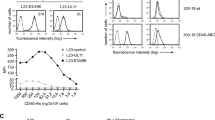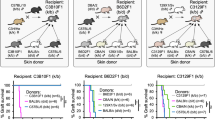Abstract
THE tissue incompatibility revealed by homografting is due to individual antigenic differences that cause the recipient to produce an immunity response to tissues grafted from another individual. Billingham, Brent and Medawar1 used a transplantation immunity test in inbred strains of mice when studying the antigens responsible for the homograft reaction, and formulated the hypothesis that nuclear nucleo-proteins or lipoproteins associated with them were responsible for transplantation immunity. The activity of nuclear fragments was not destroyed by the action of ribonuclease or trypsin but was destroyed by the action of deoxyribonuclease. We therefore decided to test whether tissue deoxyribonucleic acid itself acts as an antigenic stimulus in homotransplantation.
This is a preview of subscription content, access via your institution
Access options
Subscribe to this journal
Receive 51 print issues and online access
$199.00 per year
only $3.90 per issue
Buy this article
- Purchase on Springer Link
- Instant access to full article PDF
Prices may be subject to local taxes which are calculated during checkout
Similar content being viewed by others
References
Billingham, R. E., Brent, L., and Medawar, P. B., Nature, 178, 514 (1956).
Zamenhof, St., Griboff, G., and Marullo, N., Biochim. Biophys. Acta, 13, 459 (1954).
Author information
Authors and Affiliations
Rights and permissions
About this article
Cite this article
HAŠKOVÁ, V., HRUBEŠOVÁ, M. Part played by Deoxyribonucleic Acid in Transplantation Immunity. Nature 182, 61–62 (1958). https://doi.org/10.1038/182061a0
Issue Date:
DOI: https://doi.org/10.1038/182061a0
This article is cited by
-
Chemical Nature of Mouse Histocompatibility Antigens
Nature (1962)
-
Nucleic Acids as Transplantation Antigens
Nature (1961)
-
Homotransplant Antigens: Preparation of Active Cellular Fractions
Nature (1960)
-
Immunization with Biologically Active Fractions of Deoxyribonucleic Acid and Subsequent Specific Infection of Mice
Nature (1959)
Comments
By submitting a comment you agree to abide by our Terms and Community Guidelines. If you find something abusive or that does not comply with our terms or guidelines please flag it as inappropriate.



